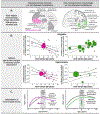Interpersonal early adversity demonstrates dissimilarity from early socioeconomic disadvantage in the course of human brain development: A meta-analysis
- PMID: 37141961
- PMCID: PMC10247458
- DOI: 10.1016/j.neubiorev.2023.105210
Interpersonal early adversity demonstrates dissimilarity from early socioeconomic disadvantage in the course of human brain development: A meta-analysis
Abstract
It has been established that early-life adversity impacts brain development, but the role of development itself has largely been ignored. We take a developmentally-sensitive approach to examine the neurodevelopmental sequelae of early adversity in a preregistered meta-analysis of 27,234 youth (birth to 18-years-old), providing the largest group of adversity-exposed youth to date. Findings demonstrate that early-life adversity does not have an ontogenetically uniform impact on brain volumes, but instead exhibits age-, experience-, and region-specific associations. Relative to non-exposed comparisons, interpersonal early adversity (e.g., family-based maltreatment) was associated with initially larger volumes in frontolimbic regions until ∼10-years-old, after which these exposures were linked to increasingly smaller volumes. By contrast, socioeconomic disadvantage (e.g., poverty) was associated with smaller volumes in temporal-limbic regions in childhood, which were attenuated at older ages. These findings advance ongoing debates regarding why, when, and how early-life adversity shapes later neural outcomes.
Keywords: Adolescence; Adverse experiences; Brain structure; Childhood; Development; Early life stress; Maltreatment; Neurodevelopment; Poverty.
Copyright © 2023 Elsevier Ltd. All rights reserved.
Conflict of interest statement
Declarations of Competing Interest None.
Figures


Update of
-
Interpersonal early adversity demonstrates dissimilarity from early socioeconomic disadvantage in the course of human brain development: A meta-analysis.bioRxiv [Preprint]. 2023 Feb 18:2023.02.16.528877. doi: 10.1101/2023.02.16.528877. bioRxiv. 2023. Update in: Neurosci Biobehav Rev. 2023 Jul;150:105210. doi: 10.1016/j.neubiorev.2023.105210. PMID: 36824818 Free PMC article. Updated. Preprint.
References
-
- Baldwin JR, Sallis HM, Schoeler T, Taylor MJ, Kwong AS, Tielbeek JJ, Barkhuizen W, Warrier V, Howe LD, Danese A, McCrory E, 2023. A genetically informed Registered Report on adverse childhood experiences and mental health. Nat. Hum. Behav 7(2), 269–290. 10.1038/s41562-022-01482-9 - DOI - PMC - PubMed
-
- Barch DM, Donohue MR, Elsayed NM, Gilbert K, Harms MP, Hennefield L, Herzberg M, Kandala S, Karcher NR, Jackson JJ, Luking KR, Rappaport BI, Sanders A, Taylor R, Tillman R, Vogel AC, Whalen D, Luby JL, 2022. Early childhood socioeconomic status and cognitive and adaptive outcomes at the transition to adulthood: the mediating role of gray matter development across 5 scan waves. Biol. Psychiatry Cogn. Neurosci. Neuroimaging 7(1), 10.1016/j.bpsc.2021.07.002 - DOI - PMC - PubMed
Publication types
MeSH terms
Grants and funding
LinkOut - more resources
Full Text Sources

